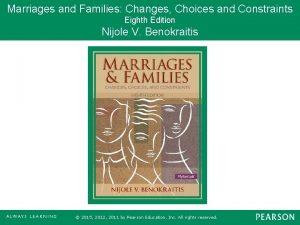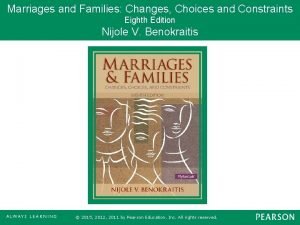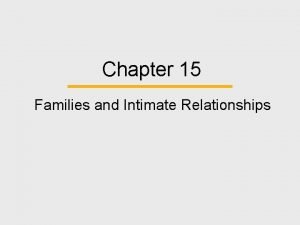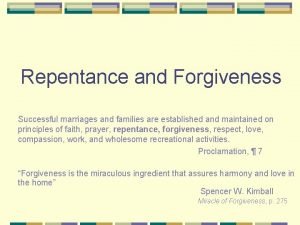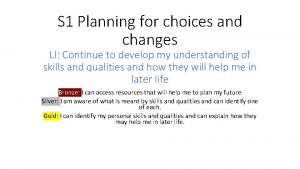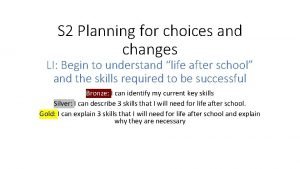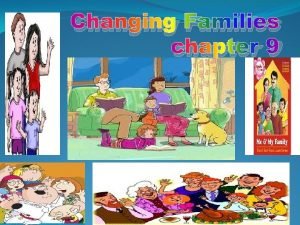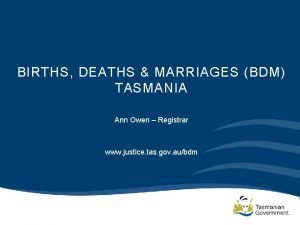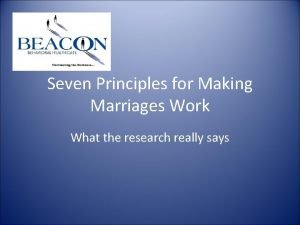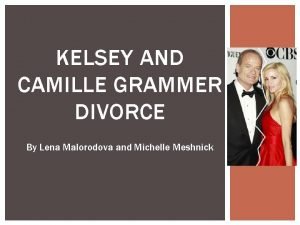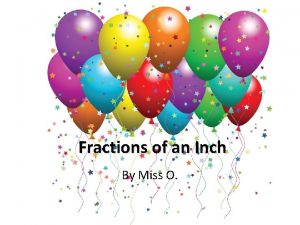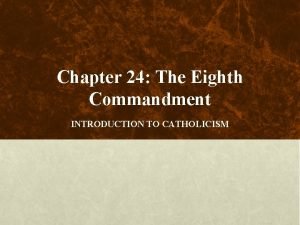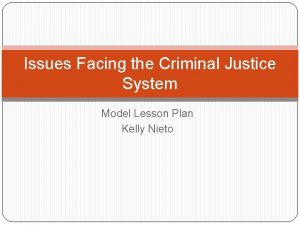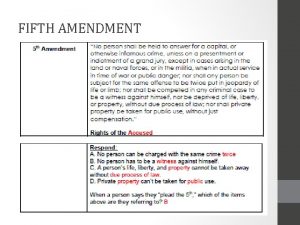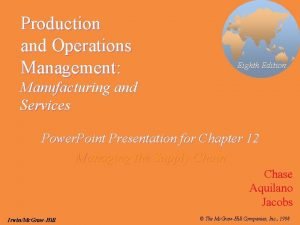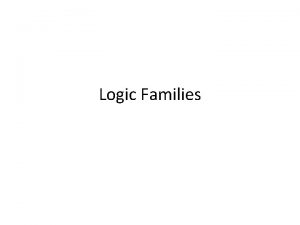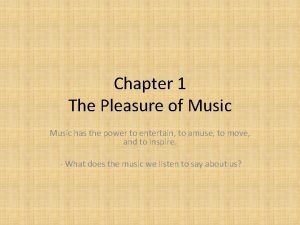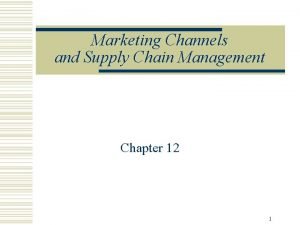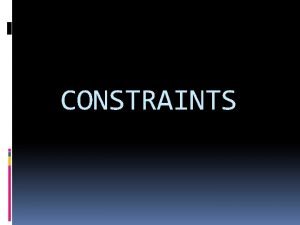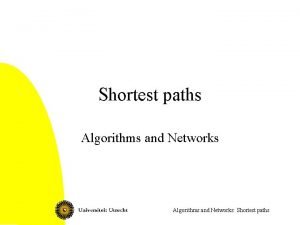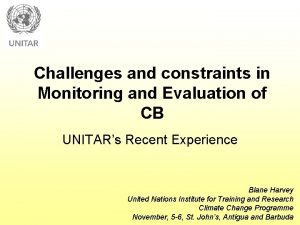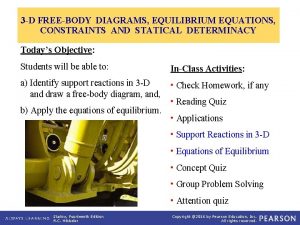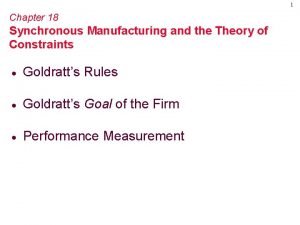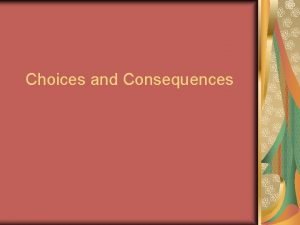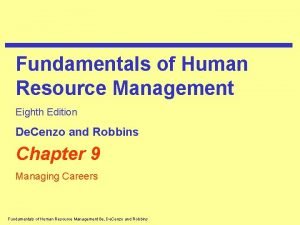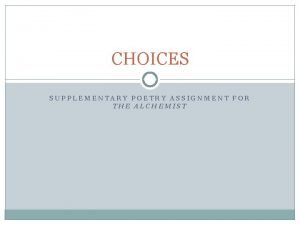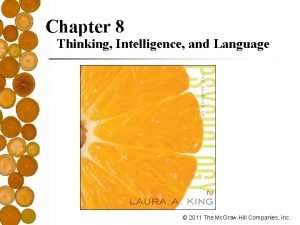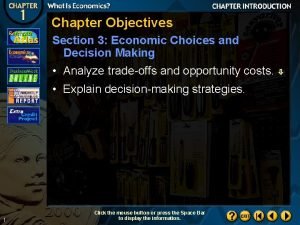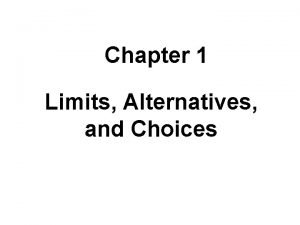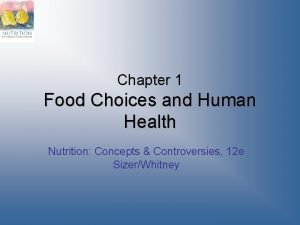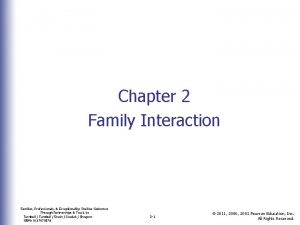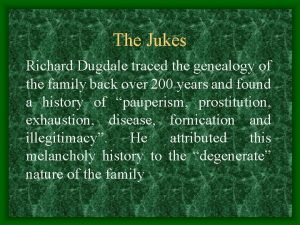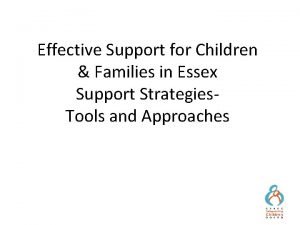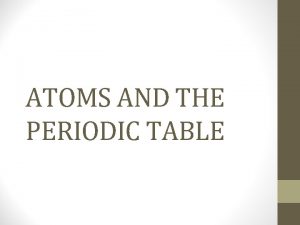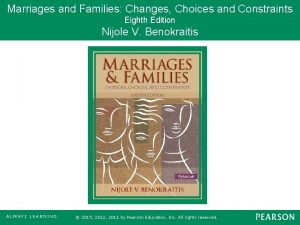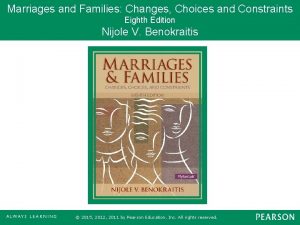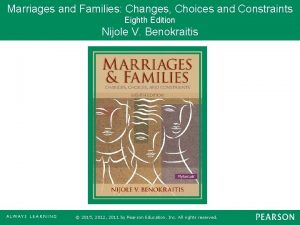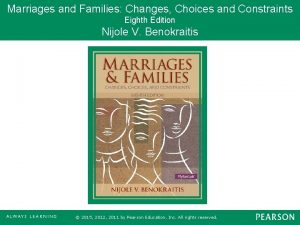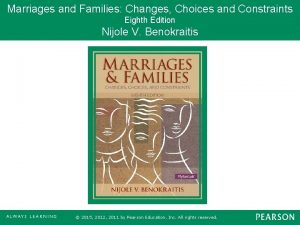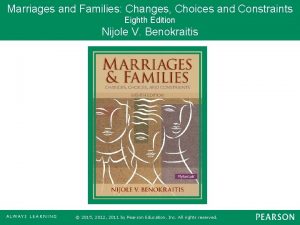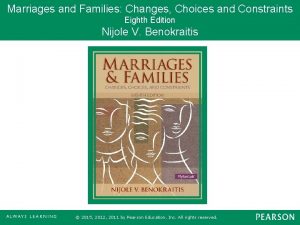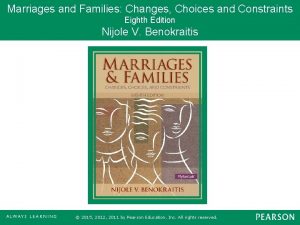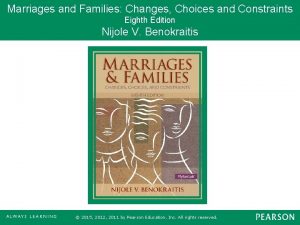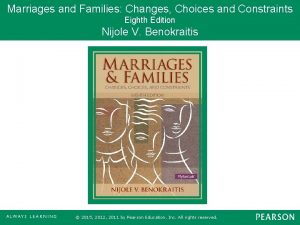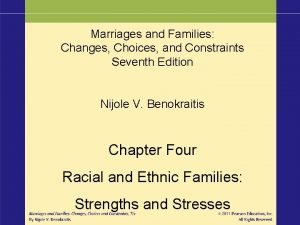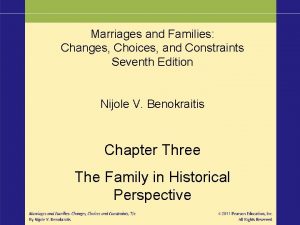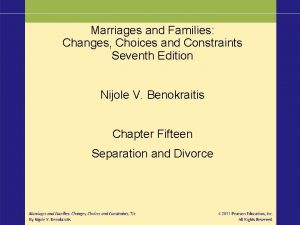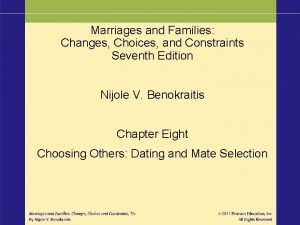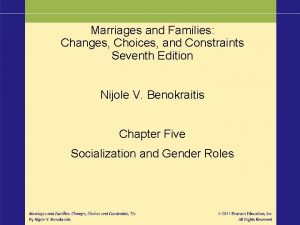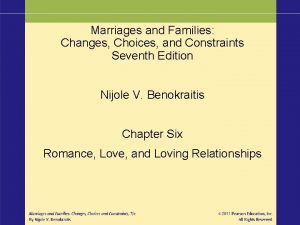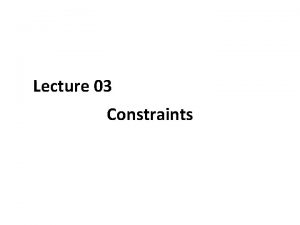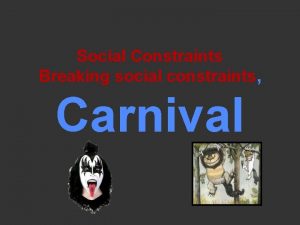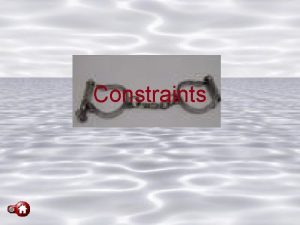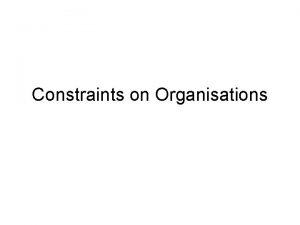Marriages and Families Changes Choices and Constraints Eighth

























































- Slides: 57

Marriages and Families: Changes, Choices and Constraints Eighth Edition Nijole V. Benokraitis © 2015, 2012, 2011 by Pearson Education, Inc. All rights reserved.

Intimate Partner Violence and Abuse • Types of intimate partner violence • Prevalence and severity of intimate partner violence • Some characteristics of abusive and violent households • Marital rape Marriages and Families: Changes, Choices and Constraints, 8 e © 2015, 2012, 2011 by Pearson Education, Inc. All rights reserved.

Intimate Partner Violence and Abuse • The cycle of domestic violence • Why do women stay? • Women who abuse men Marriages and Families: Changes, Choices and Constraints, 8 e © 2015, 2012, 2011 by Pearson Education, Inc. All rights reserved.

Intimate Partner Violence and Abuse • Abuse between two people in a close relationship • Intimate partner - Current and former spouses Marriages and Families: Changes, Choices and Constraints, 8 e © 2015, 2012, 2011 by Pearson Education, Inc. All rights reserved.

Types of Intimate Partner Violence (IPV) Physical abuse • Threatening, trying, or hurting a partner using physical force Sexual abuse • Threatening or forcing a partner to take part in a sex act when she or he doesn’t consent Emotional abuse • Aggressive behavior that threatens, monitors, or controls a partner Marriages and Families: Changes, Choices and Constraints, 8 e © 2015, 2012, 2011 by Pearson Education, Inc. All rights reserved.

Prevalence and Severity of Intimate Partner Violence • Estimates suggest each year, IPV results in: – 1, 200 deaths – 2 million injuries • Women are much more likely to report serious psychological distress – Experience serious physical injuries Marriages and Families: Changes, Choices and Constraints, 8 e © 2015, 2012, 2011 by Pearson Education, Inc. All rights reserved.

Figure 14. 1 - Intimate Partner Violence, by Sex, 1993– 2010 Rate per 1, 000 persons age 12 or older Source: Based on Catalano, 2012, Appendix Table 1. Marriages and Families: Changes, Choices and Constraints, 8 e © 2015, 2012, 2011 by Pearson Education, Inc. All rights reserved.

Figure 14. 2 - Homicides of Intimate Partners, by Relationship of the Victim to Offender, 1980– 2008 Source: Cooper and Smith, 2011, Figure 28. Marriages and Families: Changes, Choices and Constraints, 8 e © 2015, 2012, 2011 by Pearson Education, Inc. All rights reserved.

Some Characteristics of Abusive and Violent Households • IPV varies in terms of: – Gender • Familycide: Murdering one’s spouse, ex-spouse, children, or other relatives before attempting or committing suicide – Age – Race and ethnicity – Social class Marriages and Families: Changes, Choices and Constraints, 8 e © 2015, 2012, 2011 by Pearson Education, Inc. All rights reserved.

Marital Rape • Man forces his wife to have unwanted sexual intercourse • Crime in all states since 1993 – Offenders are rarely prosecuted • Most common type of rape in U. S Marriages and Families: Changes, Choices and Constraints, 8 e © 2015, 2012, 2011 by Pearson Education, Inc. All rights reserved.

The Cycle of Domestic Violence • Battered-woman syndrome: Woman who has experienced many years of physical abuse but feels unable to leave her partner • Phases – Tension-building phase – Acute battering incident – The honeymoon phase Marriages and Families: Changes, Choices and Constraints, 8 e © 2015, 2012, 2011 by Pearson Education, Inc. All rights reserved.

Why Do Women Stay? Negative self-concept and low self-esteem Belief that the abuser will change Economic hardship and homelessness Need for child support Shame or guilt Blaming themselves Fear Marriages and Families: Changes, Choices and Constraints, 8 e © 2015, 2012, 2011 by Pearson Education, Inc. All rights reserved.

Women Who Abuse Men • Situational couple violence - Both partners are perpetrators • Violence is a result of conflict that: – Turns into disagreements – Escalates to: • Arguments • Verbal abuse • Physical violence Marriages and Families: Changes, Choices and Constraints, 8 e © 2015, 2012, 2011 by Pearson Education, Inc. All rights reserved.

Child Maltreatment • What is child maltreatment? • Prevalence and characteristics of child maltreatment • Sexual abuse and incest • Polyvictimization • Why do adults abuse children? • How abuse affects children Marriages and Families: Changes, Choices and Constraints, 8 e © 2015, 2012, 2011 by Pearson Education, Inc. All rights reserved.

What Is Child Maltreatment? • Broad range of behaviors that place a child at serious risk or result in serious harm • Types – Physical abuse – Sexual abuse – Neglect – Emotional abuse Marriages and Families: Changes, Choices and Constraints, 8 e © 2015, 2012, 2011 by Pearson Education, Inc. All rights reserved.

Prevalence and Characteristics of Child Maltreatment • Child maltreatment rates in the United States have decreased – Many cases go undetected • Most victims are maltreated by one or both parents • Homicide is the leading cause of death among infants Marriages and Families: Changes, Choices and Constraints, 8 e © 2015, 2012, 2011 by Pearson Education, Inc. All rights reserved.

Figure 14. 3 - Types of Child Maltreatment, 2011 Source: Based on U. S. Department of Health and Human Services, 2012 a, Table 3 -8. Marriages and Families: Changes, Choices and Constraints, 8 e © 2015, 2012, 2011 by Pearson Education, Inc. All rights reserved.

Figure 14. 4 - Child Victimization Rates by Race and Ethnicity, 2011 Source: Based on U. S. Department of Health and Human Services, 2012 a, Table 3 -6. Marriages and Families: Changes, Choices and Constraints, 8 e © 2015, 2012, 2011 by Pearson Education, Inc. All rights reserved.

Figure 14. 5 - Who Kills Children? Source: Based on U. S. Department of Health and Human Services, 2012 a, Exhibit 4 -E Marriages and Families: Changes, Choices and Constraints, 8 e © 2015, 2012, 2011 by Pearson Education, Inc. All rights reserved.

Sexual Abuse and Incest • 90 percent of offenses are perpetrated by: – Family members – Friends of the family – Other persons children know • Abuse usually begins when the child is between 8 and 12 years old Marriages and Families: Changes, Choices and Constraints, 8 e © 2015, 2012, 2011 by Pearson Education, Inc. All rights reserved.

Figure 14. 6 - Sexual Abuse by Child’s Age, 2011 Source: Based on U. S. Department of Health and Human Services, 2012 a, Exhibit 3 -G. Marriages and Families: Changes, Choices and Constraints, 8 e © 2015, 2012, 2011 by Pearson Education, Inc. All rights reserved.

Signs of Physical Abuse Physical signs • Unexplained bruises, welts, human bite marks, bald spots • Unexplained burns, especially cigarette burns or immersion burns • Unexplained fractures, lacerations, or abrasions Behavioral signs • Acts self-destructively, Is withdrawn and aggressive, displays behavioral extremes • Arrives at school early or stays late, as if afraid to be at home • Is uncomfortable with physical contact • Displays chronic runaway behavior • Complains of soreness or moves uncomfortably • Wears inappropriate clothing to cover bruises Marriages and Families: Changes, Choices and Constraints, 8 e © 2015, 2012, 2011 by Pearson Education, Inc. All rights reserved.

Signs of Physical Neglect Physical signs • • Abandonment Unattended medical needs Consistent hunger, inappropriate dress, poor hygiene Lice, distended stomach, emaciation Behavioral signs • • • Is fatigued, listless, sleepy Steals food, begs from classmates Reports that no caretaker is at home Is frequently absent or tardy Drops out of school Marriages and Families: Changes, Choices and Constraints, 8 e © 2015, 2012, 2011 by Pearson Education, Inc. All rights reserved.

Signs of Sexual Abuse: Physical Signs • • • Torn, stained, or bloody underclothing Pain or itching in genital area Difficulty walking or sitting Bruises or bleeding from external genitalia Sexually transmitted disease Frequent urinary or yeast infections Marriages and Families: Changes, Choices and Constraints, 8 e © 2015, 2012, 2011 by Pearson Education, Inc. All rights reserved.

Signs of Sexual Abuse: Behavioral Signs • Withdraws or is chronically depressed • Is excessively seductive or promiscuous • Displays role reversal and lack of selfesteem • Experiences drastic weight gain or loss Marriages and Families: Changes, Choices and Constraints, 8 e © 2015, 2012, 2011 by Pearson Education, Inc. All rights reserved.

Signs of Emotional Neglect Physical signs • • Speech disorders Delayed physical development Substance abuse Ulcers, asthma, severe allergies Behavioral signs • Exhibits habit disorders, delinquent behavior and developmental delay • Is antisocial and responsible for destructive acts • Displays neurotic traits • Swings between passive and aggressive behaviors Marriages and Families: Changes, Choices and Constraints, 8 e © 2015, 2012, 2011 by Pearson Education, Inc. All rights reserved.

Polyvictimization • Experiencing multiple kinds of victimization • Direct victimization - Parental emotional abuse • Indirect victimization - Witnessing family violence Marriages and Families: Changes, Choices and Constraints, 8 e © 2015, 2012, 2011 by Pearson Education, Inc. All rights reserved.

Why Do Adults Abuse Children? • • • Substance abuse Stress Poverty Partner violence Divorce Marriages and Families: Changes, Choices and Constraints, 8 e © 2015, 2012, 2011 by Pearson Education, Inc. All rights reserved.

How Abuse Affects Children • • Physiological problems Social problems Emotional problems Increases the likelihood of being arrested as a juvenile Marriages and Families: Changes, Choices and Constraints, 8 e © 2015, 2012, 2011 by Pearson Education, Inc. All rights reserved.

Hidden Victims: Siblings and Adolescents • Sibling abuse • Adolescent abuse Marriages and Families: Changes, Choices and Constraints, 8 e © 2015, 2012, 2011 by Pearson Education, Inc. All rights reserved.

Sibling Abuse • Physical, emotional, and sexual abuse among siblings – Leaves lasting emotional scars • Sibling aggression increases children’s: – Depression and anxiety – Anger that last many years • Siblicide: Killing a brother or sister Marriages and Families: Changes, Choices and Constraints, 8 e © 2015, 2012, 2011 by Pearson Education, Inc. All rights reserved.

Adolescent Abuse • Parents use physical force to assert control • Consequences – Physical or verbal aggression – Rebel or withdraw – Use alcohol and other drugs – Juvenile prostitution and pornography – Commit suicide Marriages and Families: Changes, Choices and Constraints, 8 e © 2015, 2012, 2011 by Pearson Education, Inc. All rights reserved.

Elder mistreatment • • What is elder mistreatment? Who are the victims? Who are the abusers? Why do they do it? Marriages and Families: Changes, Choices and Constraints, 8 e © 2015, 2012, 2011 by Pearson Education, Inc. All rights reserved.

What Is Elder Mistreatment? • Single or repeated act, or failing to do something, by a caregiver that results in harm or a risk of harm to an older person • Elders experience at least one type of mistreatment Marriages and Families: Changes, Choices and Constraints, 8 e © 2015, 2012, 2011 by Pearson Education, Inc. All rights reserved.

Who Are the Victims? • 83 percent are white and average is 76 • 76 percent are women and 84 percent live in their own homes • 86 percent have a chronic disease or other health condition • 57 percent are married or cohabiting Marriages and Families: Changes, Choices and Constraints, 8 e © 2015, 2012, 2011 by Pearson Education, Inc. All rights reserved.

Who Are the Abusers? • • Adult children Spouses Other family members Cohabiting partners Acquaintances Neighbors Nonfamily service providers Marriages and Families: Changes, Choices and Constraints, 8 e © 2015, 2012, 2011 by Pearson Education, Inc. All rights reserved.

Table 14. 4 - Relationship of Perpetrators and Victims of Elder Mistreatment Source: Based on Acierno et al. , 2009, Exhibits 2– 5. Marriages and Families: Changes, Choices and Constraints, 8 e © 2015, 2012, 2011 by Pearson Education, Inc. All rights reserved.

Why Do They Do It? Living arrangements Low social support Alcohol abuse Impairment of the caregiver or the care recipient Dependence on the caregiver Financial stress Personality Marriages and Families: Changes, Choices and Constraints, 8 e © 2015, 2012, 2011 by Pearson Education, Inc. All rights reserved.

Violence Among Same-Sex Couples and Racial-Ethnic Groups • Same-sex couples • Racial-ethnic groups Marriages and Families: Changes, Choices and Constraints, 8 e © 2015, 2012, 2011 by Pearson Education, Inc. All rights reserved.

Racial-Ethnic Groups • Women have higher victimization rates than men – Women too are offenders • Experiencing victimization varies by: – Socioeconomic status – National origin – External stressors – Other factors Marriages and Families: Changes, Choices and Constraints, 8 e © 2015, 2012, 2011 by Pearson Education, Inc. All rights reserved.

Figure 14. 7 - Lifetime Prevalence of Rape, Physical Violence, and/or Stalking by an Intimate Partner, by Race/Ethnicity and Sex, 2010 Source: Based on Black et al. , 2011, Tables 4. 3 and 4. 4 Marriages and Families: Changes, Choices and Constraints, 8 e © 2015, 2012, 2011 by Pearson Education, Inc. All rights reserved.

Explaining Family Abuse and Violence • • • Feminist theories Social learning theory Resource theory Social exchange theory Ecological systems theory Using several theories Marriages and Families: Changes, Choices and Constraints, 8 e © 2015, 2012, 2011 by Pearson Education, Inc. All rights reserved.

Feminist Theories • Male aggression against women and children is common in patriarchal societies • Women resort to aggression to resist men’s control and domination – Less likely to result in injuries Marriages and Families: Changes, Choices and Constraints, 8 e © 2015, 2012, 2011 by Pearson Education, Inc. All rights reserved.

Social Learning Theory • We learn by observing the behavior of others • Continuous exposure to abuse and violence during childhood increases the likelihood that a person will be: – Assailant – Victim Marriages and Families: Changes, Choices and Constraints, 8 e © 2015, 2012, 2011 by Pearson Education, Inc. All rights reserved.

Resource Theory • Men have more power than women because they command greater: – Financial resources – Educational resources – Social resources • Men with the fewest resources are the most likely to resort to abuse Marriages and Families: Changes, Choices and Constraints, 8 e © 2015, 2012, 2011 by Pearson Education, Inc. All rights reserved.

Social Exchange Theory • Assailants and victims tolerate or engage in violent behavior because they believe that the benefits outweigh the costs • Costs of violence – Victim might fight back – Imprisonment leading to loss of status – Breaking up the family Marriages and Families: Changes, Choices and Constraints, 8 e © 2015, 2012, 2011 by Pearson Education, Inc. All rights reserved.

Ecological Systems Theory • Domestic violence is a result of the relationships between individuals and larger systems – Economy – Education – State agencies – Community Marriages and Families: Changes, Choices and Constraints, 8 e © 2015, 2012, 2011 by Pearson Education, Inc. All rights reserved.

Using Several Theories • Reasons for human behavior are complex including: – IPV – Domestic violence Marriages and Families: Changes, Choices and Constraints, 8 e © 2015, 2012, 2011 by Pearson Education, Inc. All rights reserved.

Other Family Health Issues • Lifestyle choices • Depression and suicide Marriages and Families: Changes, Choices and Constraints, 8 e © 2015, 2012, 2011 by Pearson Education, Inc. All rights reserved.

Figure 14. 9 - U. S. Adult Obesity Has Increased Since 1962 Percentage of obese adults ages 20 to 74 Sources: Based on Ogden and Carroll, 2010 b; Finkelstein et al. , 2012; Ogden et al. , 2012. Marriages and Families: Changes, Choices and Constraints, 8 e © 2015, 2012, 2011 by Pearson Education, Inc. All rights reserved.

Depression and Suicide • Depression: Mental disorder characterized by persistent sadness and loss of interest in everyday activities – Increases the likelihood of suicide – Suicide - Taking one’s life Marriages and Families: Changes, Choices and Constraints, 8 e © 2015, 2012, 2011 by Pearson Education, Inc. All rights reserved.

Table 14. 6 - Some Symptoms of Depression Marriages and Families: Changes, Choices and Constraints, 8 e © 2015, 2012, 2011 by Pearson Education, Inc. All rights reserved.

Figure 14. 10 - Women Are More Likely Than Men to Feel Depressed Source: Clarke and Blackwell, 2013: 138. Marriages and Families: Changes, Choices and Constraints, 8 e © 2015, 2012, 2011 by Pearson Education, Inc. All rights reserved.

Table 14. 7 - Some Common Warning Signs of Suicide Marriages and Families: Changes, Choices and Constraints, 8 e © 2015, 2012, 2011 by Pearson Education, Inc. All rights reserved.

Combating Domestic Violence and Other Family Health Problems • Prevention • Intervention Marriages and Families: Changes, Choices and Constraints, 8 e © 2015, 2012, 2011 by Pearson Education, Inc. All rights reserved.

Prevention • Preventing domestic violence begins at home • Domestic violence can be decreased by: – Adults’ solving conflict without being aggressive – Teaching children that being a perpetrator is unacceptable Marriages and Families: Changes, Choices and Constraints, 8 e © 2015, 2012, 2011 by Pearson Education, Inc. All rights reserved.

Intervention • Programs and laws designed to intervene in family crises – Successful in majority of cases – Ineffective when: • Staff is overworked • Agency is underfunded • Police and judges don’t enforce domestic violence laws Marriages and Families: Changes, Choices and Constraints, 8 e © 2015, 2012, 2011 by Pearson Education, Inc. All rights reserved.
 Marriages and families changes choices and constraints
Marriages and families changes choices and constraints Marriages and families changes choices and constraints
Marriages and families changes choices and constraints Family of orientation
Family of orientation Successful marriages and families
Successful marriages and families Little families
Little families Summary sentence starters
Summary sentence starters Planning for choices and changes
Planning for choices and changes Changing families class 4 evs lesson plan
Changing families class 4 evs lesson plan Tasmania births deaths and marriages
Tasmania births deaths and marriages Changes in latitudes, changes in attitudes meaning
Changes in latitudes, changes in attitudes meaning Physical change examples
Physical change examples Making marriages work
Making marriages work Transgender genogram symbols
Transgender genogram symbols Smart marriages
Smart marriages Cody kelsey divorce
Cody kelsey divorce The fifth, sixth, seventh, and eighth amendments protect *
The fifth, sixth, seventh, and eighth amendments protect * Anagram of eighth
Anagram of eighth Psychology eighth edition david g myers
Psychology eighth edition david g myers Eighth planet from the sun
Eighth planet from the sun Quarter inch fraction
Quarter inch fraction Reuptake psychology
Reuptake psychology Eighth commandment catholic
Eighth commandment catholic Katja mahal
Katja mahal Arterier og vener
Arterier og vener Eighth amendment excessive bail
Eighth amendment excessive bail Eighth letter of the alphabet
Eighth letter of the alphabet Criminal justice lesson
Criminal justice lesson Seventh amendment meaning
Seventh amendment meaning Operations management eighth edition
Operations management eighth edition Characteristics of logic
Characteristics of logic Compare and contrast the bach and marsalis families
Compare and contrast the bach and marsalis families Compare and contrast the bach and marsalis families
Compare and contrast the bach and marsalis families Channel design decisions
Channel design decisions Scleronomous constraints have
Scleronomous constraints have Xml constraints
Xml constraints Improperly constrained
Improperly constrained Difference constraints and shortest paths
Difference constraints and shortest paths Difference constraints and shortest paths
Difference constraints and shortest paths Accounting constraints
Accounting constraints Constraints in monitoring and evaluation
Constraints in monitoring and evaluation Gtt design process
Gtt design process Constraints and statical determinacy
Constraints and statical determinacy Synchronous manufacturing
Synchronous manufacturing Weigh the consequences
Weigh the consequences Is evaluating alternatives and making choices among them.
Is evaluating alternatives and making choices among them. Evaluating alternatives and making choices among them
Evaluating alternatives and making choices among them Career choices and preferences in hrm
Career choices and preferences in hrm Allen steble
Allen steble Chapter 8 thinking language and intelligence
Chapter 8 thinking language and intelligence What is the relationship between choices and consequences
What is the relationship between choices and consequences Chapter 1 section 3 economic choices and decision making
Chapter 1 section 3 economic choices and decision making Economizing problem definition
Economizing problem definition Earmarks of nutrition quackery
Earmarks of nutrition quackery Families professionals and exceptionality
Families professionals and exceptionality Dugdale
Dugdale Master of surprise
Master of surprise Effective support for children and families in essex
Effective support for children and families in essex Nucleus on the periodic table
Nucleus on the periodic table
